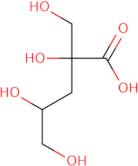
Produktinformation
- a-D-Isosaccharinic acid
- (2S,4S)-2,4,5-Trihydroxy-2-(hydroxymethyl)pentanoic acid
- 3-Deoxy-2-C-(hydroxymethyl)-<span class="text-smallcaps">D</span>-erythro-pentonic acid
- <span class="text-smallcaps">D</span>-erythro-Pentonic acid, 3-deoxy-2-C-(hydroxymethyl)-
- <span class="text-smallcaps">D</span>-gluco-Isosaccharinic acid
- pentonic acid, 3-deoxy-2-C-(hydroxymethyl)-
- α-<span class="text-smallcaps">D</span>-Glucoisosaccharinic acid
- α-<span class="text-smallcaps">D</span>-Isosaccharinic acid
- α-Glucoisosaccharinic acid
- α-Isosaccharinic acid
- Mehr Synonyme anzeigen
- α-D-Isosaccharinic acid
- D-gluco-Isosaccharinic acid
- 3-Deoxy-2-C-(hydroxymethyl)-D-erythro-pentonic acid
- D-erythro-Pentonic acid, 3-deoxy-2-C-(hydroxymethyl)-
- α-D-Glucoisosaccharinic acid
Isosaccharinic acid is a bacterial strain that produces isosaccharinic acid as its main fatty acid. The thermodynamic data for the reaction mechanism of the conversion of glucose to isosaccharinic acid has been determined. Isosaccharinic acid formation is catalyzed by an enzyme called glycosyl-glycerate dehydrogenase, which converts glycerate to 3-hydroxypropanoic acid and then to 3-oxopropanoate before it undergoes decarboxylation and reduction to form isosaccharinic acid. Radionuclides such as TcO4 are used in chemical ionization mass spectrometry for the detection of this compound in samples. Neutral pH, high activation energies, and low binding constants are all factors that affect the stability of this molecule.
Chemische Eigenschaften
Technische Anfrage zu: 3D-MI08218 Isosaccharinic acid
Wenn Sie ein Angebot anfordern oder eine Bestellung aufgeben möchten, legen Sie stattdessen die gewünschten Produkte in Ihren Warenkorb und fordern Sie dann ein Angebot oder eine Bestellung an aus dem Warenkorb. Es ist schneller, billiger und Sie können von den verfügbaren Rabatten und anderen Vorteilen profitieren.





